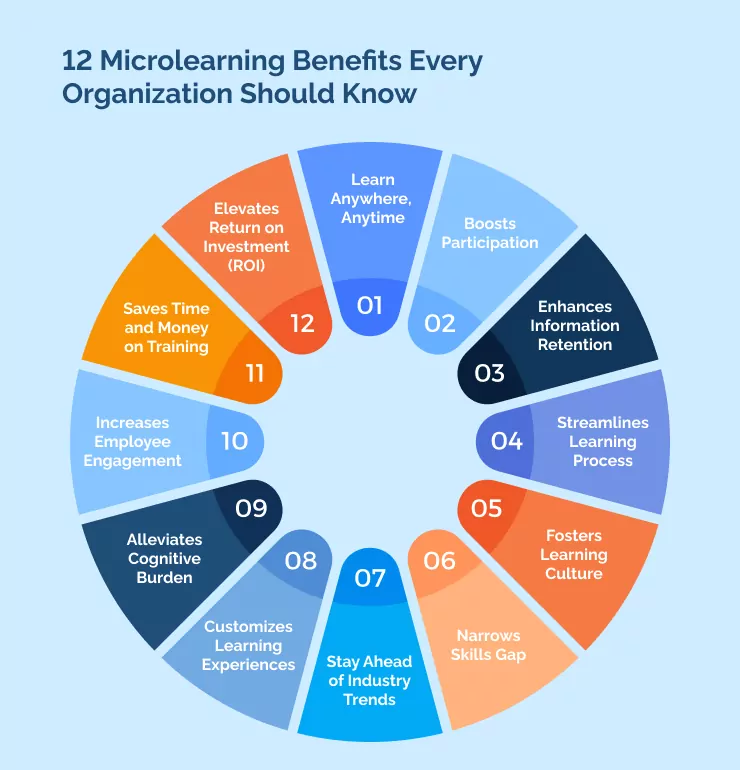
In recent years, there’s been a major shift in how we work. Evolving macroeconomic factors combined with the rise of hybrid and remote work spurred on by COVID-19 have seen traditional working models swapped out for more modern productivity processes.
Now more than ever, workers worldwide are re-examining the nature of work, and employers increasingly recognize that embracing novel working models results in employees delivering more value and improved organizational development.
A recent sdworx study found that 61% of European employees believe remote work increases individual productivity. Moreover, 72% of European employees feel that remote work provides a better work-life balance.

Like remote and hybrid work, microlearning has been gaining traction in recent years as another modern and flexible approach to productivity that caters to the needs and preferences of the modern workforce.
As the name suggests, microlearning involves learning in small, bite-sized modules. It’s a learning approach that has been shown to have numerous benefits for learners and organizations alike.
In this article, we will explore twelve benefits of microlearning. From enhancing information retention to customized learning experiences, microlearning has changed the game regarding corporate training. We will delve into how microlearning benefits can revolutionize your organization’s training process and offer practical tips on implementing microlearning effectively.
What is microlearning?

Microlearning is a learning approach that delivers content in short, focused modules that can be consumed on demand.
These modules are typically no longer than 10 minutes and sometimes as short as a few seconds, making them easily digestible and accessible. The content is designed to be highly targeted and specific to the learner’s needs, allowing optimal retention and engagement.
According to IBM, the time required to close a skills gap through traditional training has drastically increased over the past four years. The duration has surged from a mere three days to a staggering 36 days, emphasizing a need for more innovative and efficient avenues of productive learning.
12 Microlearning Benefits Every Organization Should Know

With research showing the demand for professional eLearning has grown exponentially in the wake of COVID-19, microlearning has quickly become a go-to solution for organizations looking to upskill their employees with targeted, flexible, and engaging training solutions.
Below we delve into twelve surprising benefits of microlearning that every organization should know if they hope to remain future-ready in response to the shifting nature of work.
- Learn Anywhere, Anytime
Microlearning enables learners to access training modules from anywhere at any time. This allows employees to learn on their own schedule and at their own pace, improving knowledge retention and overall productivity.
According to Global Workplace Analytics, a survey of 1,500 technology professionals found that 37% are willing to accept a 10% decrease in pay if given the option to work from home.

With microlearning, learners no longer have to be confined to traditional in-house training, making it ideal for remote or hybrid work environments.
- Boosts Participation
Microlearning is designed to be highly engaging and interactive, promoting active participation and collaboration among learners. This approach boosts employee motivation and leads to better learning outcomes as learners become more invested in learning and take ownership of their own development.
- Enhances Information Retention
Microlearning breaks down complex topics into short, focused modules, which can enhance information retention and recall. Studies have shown leading to stronger knowledge retention over time.
Research from the National Library of Medicine has demonstrated that through microlearning, learners are more likely to remember information presented in smaller pieces, improving knowledge retention over time.
- Streamlines Learning Process
Microlearning delivers bite-sized modules that focus on specific skills or topics, providing a more streamlined approach to learning. This enables learners to acquire the knowledge they need to perform their job more effectively without wading through extraneous material.
- Fosters Learning Culture
Microlearning promotes a culture of continuous learning as employees upskill through targeted modules. By investing in their employees’ development, organizations can foster a culture of innovation and growth.
- Narrows Skills Gap
Microlearning can be customized to target specific skill gaps within an organization, ensuring that employees are equipped with the necessary skills to support organizational success. Microlearning can help employees develop new skills and stay current with industry trends.
- Stay Ahead of Industry Trends

Microlearning can deliver timely training on emerging trends and technologies, helping organizations stay up-to-date with the latest advancements and remain competitive in their respective markets.
- Customizes Learning Experiences
Microlearning can be tailored to meet individual learners’ unique needs and preferences, enhancing engagement and knowledge retention for better learning outcomes and increased employee satisfaction.
- Alleviates Cognitive Burden
A Colonial Life study found that 20% of workers spend over 5 hours per week thinking about their stressors, while 50% lose 1-5 work hours weekly due to stress.

Microlearning modules break down complex topics into smaller, more digestible pieces, reducing the cognitive burden on learners and enabling them to focus on specific skills or topics without feeling overwhelmed.
- Increases Employee Engagement

Microlearning is designed to be engaging and interactive, encouraging employee participation and collaboration. This results in increased motivation, better learning outcomes, and improved performance.
Gallup says high engagement levels in business units lead to better customer engagement, productivity, retention, fewer accidents, and a 21% increase in profitability. Engaged workers also enjoy better health outcomes compared to their disengaged counterparts.

- Saves Time and Money on Training
Microlearning is a cost-effective alternative to traditional classroom-based training methods, reducing costs while delivering effective training solutions that save organizations time.
- Elevates Return on Investment (ROI)
By enhancing knowledge retention, improving employee engagement, and narrowing skill gaps, microlearning can significantly impact an organization’s ROI.
McKinsey reports that 43% of all reskilling cases would yield payoffs from upskilling employees in large enterprises and, in a further 30 percent of reskilling cases, small and medium-sized enterprises would receive a net benefit from upskilling their workers.

Employees becoming more skilled and productive can help drive better business outcomes, resulting in a stronger return on investment for the organization.
The Importance of Microlearning for Learning and Development

With its bite-sized chunks of information, active learning approach, and flexibility, microlearning offers an effective way for people to learn new skills and knowledge quickly and efficiently.
Its adaptable nature and ability to integrate into daily routines make it an ideal choice for industries with rapidly changing skill requirements and busy work schedules, making it a game-changer in the field of learning and development.
Microlearning can be cost-effective and time-efficient, making it ideal for organizations that want to optimize their L&D budgets. Instead of investing in expensive traditional training programs that don’t yield the desired results, organizations can leverage microlearning to deliver targeted, relevant, and engaging content to learners, increasing their engagement and motivation without disrupting their work-life balance.
As we move towards an increasingly digitally interconnected world, the value microlearning delivers for keeping up with new technologies and trends should be well within the purview of L&D leaders.
According to LinkedIn’s 2023 Workplace Report, 89% of L&D pros agree that proactively building employee skills will help navigate the evolving future of work.

Technological disruptors such as AI and virtual reality mean it’s more important than ever for L&D teams to pay attention to microlearning and its contemporary value to modern businesses.
The traditional learning and development methods are becoming obsolete in the current dynamic and unpredictable business world, where forecasts and objectives change quarterly, and the need for upskilling and reskilling is constant.
“Learning is key to your resilience as a business. If you invest in curiosity, learning, and agility for your workforce, you can bounce back from setbacks, adapt to change, and be more ready for whatever comes next,” says Cat Ward, VP of Jobs for the Future.
Microlearning provides learners with the opportunity to engage with the material in a more meaningful way, leading to greater application of knowledge.
The uncertainties caused by the COVID-19 pandemic and the demand for a more flexible and remote workforce have seen microlearning emerge as a contemporary solution for adapting to a new world. By providing an efficient, cost-effective, and flexible way for learners to acquire new skills and knowledge, microlearning can help organizations stay resilient in the face of change and uncertainty.
WalkMe Team
WalkMe spearheaded the Digital Adoption Platform (DAP) for associations to use the maximum capacity of their advanced resources. Utilizing man-made consciousness, AI, and context-oriented direction, WalkMe adds a powerful UI layer to raise the computerized proficiency, everything being equal.



